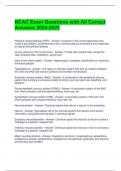Exam (elaborations)
NCAC Exam Questions with All Correct Answers
- Course
- Institution
NCAC Exam Questions with All Correct Answers Pleasure reward pathway (PRP) - Answer- Comprise of the ventral tegmental area, nucleus accumbens, and prefrontal cortex; controls persons motivations and responses to natural and artificial rewards six key sections of the human brain - Answer- F...
[Show more]



